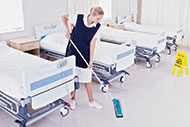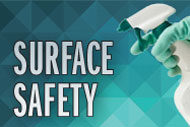 |
|---|
| This initiative is funded by an unrestricted educational grant from Clorox Healthcare™. |
Hospital cleaning and disinfection processes in patient discharge rooms have been undergoing a quiet revolution for more than a decade now. Evidence-based practices in this process, commonly known as terminal room cleaning, have become a central focus, particularly in rooms where patients were known to have or are suspected of having a health care-associated infection (HAI).
Every aspect of how bioburden is removed from the environment — from the cleaning products and disinfectants applied to the types of materials used to scrub surfaces to the deployment of high-tech systems — has been scrutinized and researched. Thousands of institutions now follow the Environmental Protection Agency's (EPA's) best practices for health care facilities by using microfiber cleaning products rather than cotton cloth products and string mops to remove more effectively organic matter from surfaces and crevices.
Visual observation of cleaning techniques, once the primary method of evaluating environmental services (ES) professionals, has been supplemented with more objective and scientific methods of evaluating cleaning thoroughness. Scores of hospitals now follow the Centers for Disease Control and Prevention (CDC) guidance, and use fluorescent marking gels and ultraviolet light after processing high-touch areas to assess cleaning thoroughness. Others use adenosine triphosphate assays to evaluate and monitor surfaces after ES cleaning.
Yet, even with these significant advances, efforts aimed at sharply reducing costly HAIs have produced far from uniform results.
As researchers Philip C. Carling, M.D., and Susan S. Huang, M.D., MPH, noted in their 2013 paper "Improving Healthcare Environmental Cleaning and Disinfection" in Infection Control & Hospital Epidemiology, " ... there remains a substantial need to better understand the clinical effectiveness and magnitude of infection prevention and patient reassurance derived from the current array of cleaning practices, various disinfectants and application methods, and technological advances."
The CDC's "National and State Healthcare-Associated Infections Progress Report" released in late March further illustrated this need. The report found that while significant improvement has been achieved in reducing such HAIs as central line-associated bloodstream infections (down 44 percent between 2008 and 2012) and 10 types of surgical-site infections that were tracked (down 20 percent), the news wasn't as positive on hospital-onset methicillin-resistant Staphylococcus aureus (MRSA) bloodstream infections and hospital-onset Clostridium difficile infections.
The CDC report found that the 2 percent drop in hospital-onset C. difficile infections between 2011 and 2012 was far below the 25 percent target goal by 2013. Similarly, hospital-onset MRSA infections dropped 4 percent during the same period.
Elsewhere, the Agency for Healthcare Research and Quality's Healthcare Cost and Utilization Project found that the number of C. difficile discharges in the United States more than doubled between 2000 and 2011.
All of this data point to the need for ES teams to redouble their efforts to consistently adhere to best cleaning and disinfection practices in their terminal room cleaning procedure bundle and other cleaning situations.
Robert M. Hodnik, CHESP, project director, UPMC Health Plan, part of the University of Pittsburgh Medical Center System, says that his organization's in-house operation for ES process for discharge cleaning mirrors the Association for the Healthcare Environment (AHE) Practice Guidance for Environmental Cleaning (second edition).
"All of our environmental services employees are given the same level of training and exposure to that process, whether we're talking about daily cleaning or terminal cleaning," says Hodnik, an at-large board member for AHE. He adds that he along with the value analysis team made up of ES directors at UPMC's 14 system hospitals, supply chain management and infection control, continue to focus on product and procedure standardization to ensure consistent results and adherence to best practices.
The AHE's Practice Guidance includes more than 40 aspects of terminal room cleaning, covering everything from hand hygiene and personal protective equipment to following a predetermined cleaning path in the room, with the restroom to be cleaned last. This deep-cleaning process is designed to render the area safe and ready for the next patient.
According to the AHE's Practice Guidance, "The environmental infection prevention strategy must include at a minimum: (1) the cleaning and disinfection of surfaces touched by patients, health care staff and visitors; and (2) cleaning environmental surfaces and surfaces with visible soil, followed by disinfection with evidence-based practice guidance."
As multidrug-resistant organisms (MDROs) can remain on even cleaned surfaces for weeks or, in the case of C. difficile, for months, it's important to use the proper types of disinfectants to optimize disinfection practices. In its six steps to C. difficile prevention, the CDC's website counsels health care organizations to: "Clean room surfaces with bleach or another EPA-approved, spore-killing disinfectant after a patient with C. difficile has been treated there."
Beyond educating and training ES staff members on proper cleaning techniques and using the correct cleaning agents and disinfectants to minimize the threat of environmentally transferred HAIs, a growing number of hospitals and health systems are looking to technology to aid in this effort. Ultraviolet (UV) light disinfection and hydrogen peroxide vapor systems, in particular, are being used by a growing number of facilities to attack C. difficile, MRSA, vancomycin-resistant enterococci and other MDROs that may persist on surfaces even after cleaning.
Hospitals deploying UV light disinfection systems often use the units in areas where the most vulnerable patients reside — isolation rooms, intensive care units, oncology areas, operating rooms, treatment areas and bathrooms where patients are known or suspected to be infected with C. difficile or other highly infectious diseases.
The Valley Hospital, a 451-licensed bed, acute care facility in Ridgewood, N.J., introduced UV light disinfection two years ago in an effort to reduce HAIs and the number of health care-associated C. difficile cases it was experiencing. Howard Halverson, director of environmental services at the facility, says all 120 of his team's full-time equivalent staff are trained to use the UV units, which are routinely used in terminal cleaning of isolation rooms, critical care units, ORs, and some specific surgical units. Judy Fernandez, manager of environmental services, emphasizes that the UV disinfection process only begins after specified cleaning and disinfection protocols have been completed.
The results have been impressive so far, notes Mitchell Rubinstein, M.D., vice president of medical affairs, who reports a 35 percent decrease in C. difficile cases from the first quarter of 2012 to the fourth quarter of 2013.
"We know that C. difficile tends to be higher in the first quarter, but these results demonstrated to us that we clearly had a decrease in C. difficile infections when the [UV] devices were used to disinfect our rooms. That's a huge leap forward for patient safety," Rubinstein says.
There are a significant number of case studies like this, and larger, more formal studies on the efficacy of UV light disinfection in conjunction with thorough cleaning and disinfection practices are ongoing. In all cases, UV technology is not designed to replace manual cleaning practices. Still, some researchers caution that there's a need for broad-based, multifacility research that measures the impact of UV disinfection systems on HAIs. In the meantime, regardless of which technologies are deployed, following standardized, evidence-based cleaning and disinfection practices outlined by the CDC, AHE and others remains essential in the fight against C. difficile and other MDROs that present in the health care environment.
Resources
- Association for the Healthcare Environment Practice Guidance on Healthcare Environmental Cleaning (second edition)
- Association for Professionals in Infection Control and Epidemiology Guide to Preventing Clostridium difficile Infections
- CDC Environmental Checklist for Monitoring Terminal Cleaning
- CDC: Options for Evaluating Environmental Cleaning





